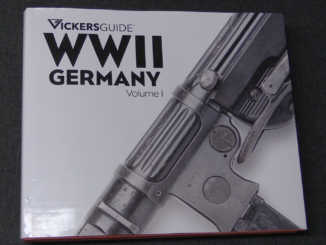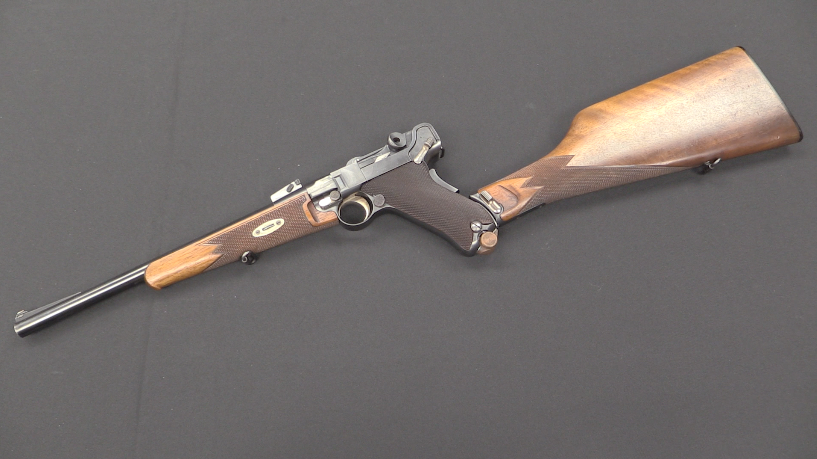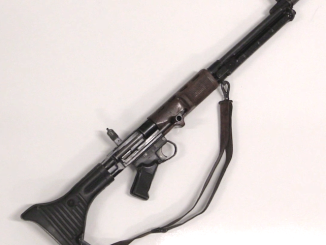Only days ahead of the French Army in April 1945, Ott-Helmuth von Lossnitzer and about 250 Mauser engineers and technicians fled Oberndorf with the core of Mauser’s new projects. They had the drawings, components, and gages for guns like the new StG-45 assault rifle, MK214 aircraft cannon, and Volkspistol and they were headed for an impregnable series of tunnels in the Austrian Alps to carry on the war. In a story that is absolutely worthy of film adaptation they scrounged a series of locomotives, dodged P47 Thunderbolt attacks, and went careening through the Alps with about 2 dozen boxcars of the most important prototype guns in the German arsenal.
Of course, the idea of continued resistance was a complete fantasy. When it did finally arrive in Ötztal, the Mauser refugees found all the tunnels already occupied by other groups with the very same idea. So they basically made camp and waited for American forces to arrive. The train was found by a British-American CIOS (Combined Intelligence Objective Subcommittee) party, the engineers were all questioned, and the train contents packed up for shipment to the UK and US. Ott-Helmuth von Lossnitzer himself emigrated to the US as part of Operation Paperclip, where he worked for Springfield Arsenal for many years until retiring in 1968 and then living in Wisconsin until his passing in 1989.
For anyone interested in this story, I highly recommend Lossnitzer’s oral recollections compiled into book form by Leslie Field and Bas Martens – ISBN 9789081737807. It is out of print now, but you may be able to find it on the secondary market.
Much more accessible is the reprinting of the original CIOS report on Mauser published by Peter Dallhammer (whom you may recall from his Textbook of Pistol Technology and Design). This is a 360-page treasure trove of details on Mauser’s ongoing R&D in 1945, and it is available on Amazon:




1) Electric locomotive – The Alps has plenty of hydro-electric power and electric traction generates maximum torque on starting and low speeds so it was a natural for Alpine railways. By the way, during WW2, Switzerland had a shortage of coal so they converted some steam engines to electric by installing electric heating elements in the firebox to heat water into steam. Truly a tonsilectomy through the rectum and highly inefficient, but it got them through the war.
2. Those must have been some ROUGH Me-262 landings. They had tricycle landing gear, which would have had to collapse in some very hard landings
3. The primary result of Mauser’s aircraft weapons was the revolver cannon MG213 and MK213,
https://en.wikipedia.org/wiki/Mauser_MG_213
which led to the US 20mm M39, British 30mm ADEN and French 30mm DEFA among others
https://en.wikipedia.org/wiki/Revolver_cannon
4. Rheinmettal got its 50mm BK-5 into action in limited numbers aboard Me-262’s
https://en.wikipedia.org/wiki/Rheinmetall_BK-5
5 The post-war Russian 57mm AA gun was based on the
http://www.navweaps.com/Weapons/WNGER_55_Gerat58.php
which was based on
https://en.wikipedia.org/wiki/5_cm_FlaK_41
https://en.wikipedia.org/wiki/AZP_S-60
which was available in both towed and self-propelled mounts and saw extensive use in the Mideast and Vietnam wars. The ZSU-57-2 was essentially a T-54 hull with a large open topped turret mounting twin 57’s – essentially equivalent to the US twin 40mm M$@
https://en.wikipedia.org/wiki/ZSU-57-2
Have fun with your reading
“(…)converted some steam engines to electric by installing electric heating elements in the firebox to heat water into steam(…)”
Photos can be seen there http://www.douglas-self.com/MUSEUM/LOCOLOCO/swisselec/swisselc.htm
“(…)ZSU-57-2 was essentially a T-54 hull with a large open topped turret mounting twin 57’s(…)”
Actually not, certain parts of T-54 yes, but whole hull not. Beyond being visually distinct by using lesser number of wheels per side, it has also much thinner armour.
“(…)US twin 40mm M$@(…)”
What is M$@? Never heard about such named vehicle earlier.
M$@ would be M42 with the shift button pressed for the last two characters as well… The M42 Duster was a US self-propelled AA gun of the 1950s, although it remained in service for surprisingly long (until 1988) with the National Guard:
https://en.wikipedia.org/wiki/M42_Duster
As for the S-60 towed AA gun system, it was also used by the Finnish Army. Its procurement process is a typical example of Cold War era Finnish Army practices and as such perhaps an interesting anecdote: in the early 1970s the Army wanted to purchase surface to air missiles to modernize the air defenses. Unfortunately the Paris peace treaty of 1948 flatly prohibited Finland from having any missiles (the intention of the clause was originally to ban weapons like the V1 and V2) and despite attempts no exemption for “defensive missiles” could not be obtained from the signatories at the time.
So, instead the Army had to settle for a new medium caliber AA gun system. The 35mm Swiss Oerlikon Skyguard system had been purchased in late 1950s and the Army wanted more of them. Unfortunately there was no money in the defense budget for new Western systems and the Army was forced to look for a Soviet system, which would be paid through the Clearing account barter system instead of hard currency. The S-60 was the only suitable one, even if the Soviets were already phasing it out for missile systems themselves. That is, by the way, why so many of them ended up in Vietnam and the Middle East with the Soviet clients there. They were giving them out like candy in the 1970s.
In any case, thus the Finnish Army ended up with an obsolescent AA gun system. A little consolation was that at least the Soviets agreed to sell it with the latest integrated fire control radar (RPK-1M1 Vaza) they had available. Beggars can’t be choosers, as the saying goes, and the system remained in service with the Finnish Army until the beginning of the new Millennium. It even received a affectionate(?) nickname: Nikolai.
“(…)surprisingly long(…)”
According to https://ru.wikipedia.org/wiki/%D0%A1-60
in Russian Federation last officers for manning this system were trained in 2007 year. Interestingly AZP-57 (gun of S-60 system) was recently used as main armament of Desert Spider remote controlled turret
https://militaryleak.com/2020/05/23/valhalla-turrets-unveils-desert-spider-remotely-controlled-short-range-air-defense-system/
I imagine that in our present day there are all sorts of experimental versions of software, biomedical, and nanotechnology projects whose source code, processes, and plans for development are settling into the fertile muck at the bottom of the river of human progress, only to give indirect birth in future years to things most of us do not imagine now.
You can ring NHS England via… Some part of it, after multiple attempts to speak to a human; and get through to a part which deals with spare parts for beds, and then insist inhibiting the bodies own immune response with alcohol is a functional way to address Rona hospitalisations… Due to inhibiting said immune response, like Dexamethosone.
But they don’t listen, vested interests you see; importing 8 million litres of Belarussian Vodka just doesn’t “grease the correct palms” travesty it is, free trade etc he he.
That late in the war, a train was a dangerous place to be-
https://www.youtube.com/watch?v=uqN_Pd58MFw
How many Thunderbolts? I’ve always understood that a sortie was a single plane’s mission. Hence a squadron of twelve planes scrambling to intercept would be twelve sorties.
Of course, von Lossnitzer probably wasn’t in any position to make an objective count…
“(…)sortie was a single plane’s mission(…)”
This was used so by RAF in 1944 according
https://api.parliament.uk/historic-hansard/commons/1944/mar/29/sortie-definition
The meaning of this term as applied to flying operations against the enemy is “one flight by one aircraft.”
Though I do not know if it had same meaning in USAAF glossary.
The irony of the 50s-60s AAA guns is that by the time they were fielded, they were all ineffective against the main 50s-60s arial threat of jet strike fighters running low at 300+ knots, and armed with tactical nukes. They could not acquire and engage swiftly enough. A ZSU-57 simply had no (no) chance of bringing down an F105 Thunderchief (though guided missiles did, see VN). It could not acquire, traverse, or fire quickly enough.
But almost as soon as they got withdrawn, a new and largely unanticipated threat emerged. The attack helo (Hind, Cobra, Apache etc) against which they would have (maybe modified slightly) been very effective. A bit like the post-Falklands 1980s rush to stick Vulcan cannons on ships to increase capability against sea-skimming anti-ship missiles (have i banged on here before about how, in the absence of precision guidance of projectiles, the best answer is just chucking stuff in the rough direction of the threat?).
These facts are largely unrelated. But there may have been a point where, say, the US guys deciding to withdraw the Skysweeper and older M40 might usefully have touched base with the US guys developing the gunship helo…
As early helicopters found out the hard way, they couldn’t endure the projectiles from the obsolete WWII flak cannons. Even a belittled Type 96 Hotchkiss-pattern 25mm three-gun mount would down a UH-1 in an ambush…
Whether an AA gun can acquire a target fast enough is largely dependant on the actual target acquisition and targeting system, that is the radar (or laser) and attached computer system. Some were better than others. The “gold standard” was Oerlikon 35mm Skyguard, which proved to be effective as late as Falklands despite being 25 years old technology at that point.
When talking about the capabilities of the ZSU-57 and the M42 Duster, one must realize that both were essentially WW2 technology. They had an electromechanical computer that was not coupled with a radar. That meant that the gun crew had to estimate both the speed and distance of the target. They would then adjust fire according to tracers. This worked reasonably well in WW2, but against fast jets it was too slow a method. The relatively slow rate of fire of the 57mm and 40mm guns was part of the problem, since it required great practical accuracy in order to hit the target. The 35mm Oerlikon was a different beast altogether with 550 rounds per minute per barrel (1100 combined). Such a RoF allowed for a bit more inaccuracy. Proximity fuses would have helped to 57mm and 40mm systems, but they were not available yet. Bofors developed a proximity fuse for the 40mm in the late 1970s for the abortive Sargeant York system, but the Soviets never bothered with the 57mm. The Chinese did develop one in the 1980s, but it was a fairly typical Chinese high tech of the 80s, that is not very good at all… (It was, incidentally, tested by the Finnish Army with rather sobering results.)
An F105 at low altitude with nukes was also the absolutely worst scenario for air defenses. Most attack planes could not deliver conventional munitions with good accuracy while flying fast and low. The necessary bombing aids needed for that didn’t become available until the introduction of digital computers in the 1970s. The door swings both ways though, and digitalization also decreased the acquisition times and increased practical accuracy of AA guns. What really killed the AA gun was not, in the end, fast jets but smart munitions, which made it possible to hit point targets accurately from above the practical reach of AA guns.
“(…)attack helo (Hind, Cobra, Apache etc) against which they would have (maybe modified slightly) been very effective(…)”
Amount of armour which can be feasibly carried by helicopter is limited.
After quick search I found that https://science.howstuffworks.com/apache-helicopter6.htm
gives resistance as 12,7-mm all around and 23-mm for certain components.
Obviously it will not withstand hit from 57 mm, but smaller systems will suffice and they might easier offer greater rate-of-fire. Soviet 23 mm 2А13 developed in 1950s https://old.weaponsystems.net/weaponsystem/EE02%20-%20ZU-23.html
has cyclic of Rate-of-Fire of 1000 rpm per barrel which gives 2000 rpm in total. As it is belt-fed it can fire much more rounds without stopping than clip-fed AZP-57.
“Soviet 23 mm 2А13 developed in 1950s https://old.weaponsystems.net/weaponsystem/EE02%20-%20ZU-23.html
has cyclic of Rate-of-Fire of 1000 rpm per barrel….As it is belt-fed it can fire much more rounds without stopping than clip-fed AZP-57.”
Well, it is a decade or more newer than the S-60 and 23 versus 57mm, so belt feed is a bit easier. The ZSU-23-4 mounts four of those guns with on mount fire control radar on a tracked chassis, I had a buddy who was an F-4 jockey and “ZSU” was a curse word in the ground attack community – its the equivalent of a Vulcan
https://en.wikipedia.org/wiki/ZSU-23-4_Shilka
https://www.youtube.com/watch?v=Uq9ZEpuZsBc
And then there’s Tunguska which goes Shilka one better with 30mm guns AND missiles
https://en.wikipedia.org/wiki/2K22_Tunguska
https://www.youtube.com/watch?v=a86E7WqY1UI
Shilka or Tunguska versus Warthog or Apache Long Bow would be one heck of a duel
And the US has nothing comparable and no plans to get something that is (Bradley Linebacker has been phased out and what is left is Avenger – not exactly terrifying) The US Army has been spoiled, it hasn’t had to face ground attack aircraft since 1943…but there may come a day when the USAF is too busy elsewhere and American troops will die
To be fair, the Avenger is not a bad system. It has a fair amount of ready Stinger missiles, which have been proven to be effective against both low altitude attack aircraft and helicopters. The gun part is rather puny, but its main purpose is supposedly self-defense against ground rather than aerial threats. That said, a fast-firing .50 cal can still be effective against helicopters. Even armored attack helicopters would definitely not like being hit by multiple .50 cal API bullets, because as has been established even in this discussion, it is impossible to armor a helicopter completely against such projectiles. More correctly one could say that they can be resistant (rather than armored) against such threats.
The Me262 crash landings are hilarious! (although only because the pilots were unhurt).
The crashes were to be expected. The Germans lost quite a few of me262’s during the war due to front landing gear collapse. The landing gear and engines were notoriously fragile.
“ A ZSU-57 simply had no (no) chance of bringing down an F105 Thunderchief (though guided missiles did, see VN). It could not acquire, traverse, or fire quickly enough.”
Yes it could.
Official USAF stats say that 283 F-105B’s and F’s were lost in combat, of which 17 were shot down by enemy fighters and 25 by missiles. That means 241 were downed by AAA. Adnittedly, the PAVN used just about anything that could be persuaded to point skyward against the “Yankee Air Pirates” (DShK, ZPU-1, ZPU-2, ZPU-4, ZU-23, 37mm M1939, 85mm M1939, 100mm KS-19, 130mm KS-30), but
“During the Vietnam War the S-60 was the keystone of North Vietnamese low-altitude air defense and was most effective between 460 meters and 1,500 meters.”
So we can conclude that the S-60 took its toll of F-105’s.
BTW, one effect of the low level AAA was to force aircraft attempting to penetrate under the radar up to where they could be engaged by missiles and interceptors.
“The performance of AAA in Vietnam against low-flying aircraft led the Soviets to bring back many guns from storage to supplement the Surface-to-Air Missiles, whose performance at low altitude was less than satisfactory.”
“the US guys deciding to withdraw the Skysweeper and older M40 might usefully have touched base with the US guys developing the gunship helo…”
What actually happened was the 37mm Vigilante
https://en.wikipedia.org/wiki/T249_Vigilante
https://www.guns.com/news/2018/12/18/vigilante-that-time-the-army-tried-to-make-a-37mm-gatling-gun-photos
was cancelled in favor of Mauler, which promised that you flipped the on switch and it acquired and instantly annihilated the target with human intervention – at which point a hatch opened, a robot arm came out and spray painted an aircraft silhouette on the mounting.
https://en.wikipedia.org/wiki/MIM-46_Mauler
Which meant the Army was reduced to marrying an Air Force gun to a Navy sight and sticking it on top of an M113
https://en.wikipedia.org/wiki/M163_VADS
and taking a Navy “dogfight” air-to-air missile (Sidewinder), cobbling together a quad mount and putting in the cargo bed of an M548
https://en.wikipedia.org/wiki/MIM-72_Chaparral
The Mauser Train sounds as fascinating as Antony Fokker’s Train in 1918 or 1919. He loaded an entire airplane factory into a train to sneak it out of defeated Germany and into neutral Holland, where Fokker continued making airplanes for another 80 years.